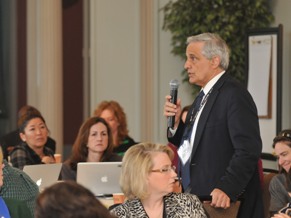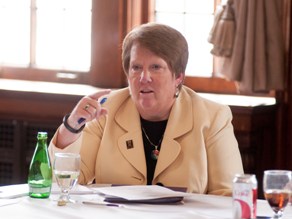Academic physicians and faculty across the country are innovating new ways to teach the physicians of tomorrow, but first, the trainers must become the trainees.
“Medical education is largely an apprenticeship system—students rotate with us and work with us in clinical settings,” said Thomas Viggiano, MD, associate dean for faculty affairs at Mayo Medical School. “If we don’t have the competencies that we want our students to have, then we are not effective role models.”
Dr. Viggiano is part of a curriculum transformation at Mayo that is overhauling the traditional model of medical school. The program will place greater emphasis on preserving wellness and health over treating disease and will embed students in communities for longitudinal clinical experiences. But the school can’t just focus on how they’ll teach students.
“We have an enormous task,” he said. “Our task is to help faculty learn about a variety of science of health care delivery topics that many faculty members did not learn when they attended medical school. The goal is for all faculty to be knowledgeable so they can discuss topics like population health and be good role models for how to practice high-value, person-centered care.”
Mayo is part of the AMA’s Accelerating Change in Medical Education initiative, which seeks to advance the education of future physicians by developing innovative training models. The 11 schools in the initiative are devising and testing things like competency-based curriculum, integrating technology into learning, and giving hands-on training in team-based care.
The school is using a blended learning model, a combination of online resources and face-to-face learning time, to get its faculty to a high level of proficiency on medical education innovations that eventually will be a core part of the school’s curriculum. A second layer of faculty development will train “champions,” or faculty with a deeper interest in these topics that can act as leaders of the new curriculum.
Taking a similar approach is the Brody School of Medicine at East Carolina University through its Teachers of Quality Academy (TQA). But there’s one major difference: The faculty participating in the TQA will be trained on medical education innovations while simultaneously creating the school’s new curriculum. Brody also is participating in the AMA initiative.
“We knew the faculty didn’t have the core content they would need, and we created the TQA to design the curriculum while training them on the content,” said Elizabeth Baxley, MD, senior associate dean for academic affairs at Brody School of Medicine. “We’re letting [faculty] serve as the larger curriculum development group. We’re starting with faculty and engaging them in helping us be the change leaders.”
Brody’s program was open to faculty from across the health sciences, including nursing and public health.
“Training this broader group gave us more hands on deck,” Dr. Baxley said. “We needed the perspective of people who weren’t in our education planning circles, and we needed to broaden the chances that these principles would get reinforced in the daily practice of teaching.”
While the approaches are different, both Brody and Mayo are experiencing the same challenges—time and money. Both schools are working to incentivize faculty development.
“How do you get busy people who are working very hard to engage in this?” said Dr. Viggiano. “The resources have to be designed very well—as concise as they can be with no wasted time and excellent quality.”





